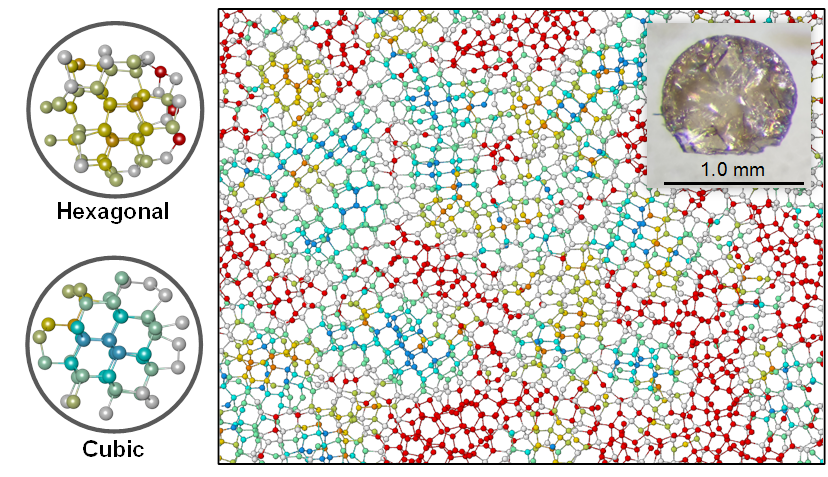Synthesis of Paracrystalline Diamond: Discovering the Rosetta Stone of Non-crystalline Materials - Dr. Huiyang Gou
NOVEMBER 25, 2021
A team of researchers by Dr.Huiyang Gou from HPSTAR and Dr. Howard Sheng from George Mason University in collaboration with Prof. Tomo Katsura at University Bayreuth, Prof. Mingsheng Wang at Xiamen University and Dr. Zhidan Zeng at HPSTAR, have discovered a new form of diamond that could fundamentally challenge our ideas about the nature of solids. Using high-pressure and high-temperature conditions, they synthesized a paracrystalline (p-D) state of diamond from a fcc-C60 precursor, revealing the missing link in the length-scale between amorphous and crystalline structures. This new member of the enriched carbon family could be further exploited to create new materials and has profound implications for recognising complex structures arising from amorphous materials. Detailed results are published in the latest edition of Nature.
Generally, solids in nature are classified into crystalline and non-crystalline states depending on whether long-range lattice periodicity is present in the material. However, the differentiation between the two states is fundamentally challenged when the crystal’s degree of long-range order is significantly reduced. To resolve this structural enigma, a paracrystalline structure model was proposed, in which nanosized paracrystallites were introduced to the amorphous matrix to account for the crystalline medium range order (MRO).
Crucially though, are we able to identify a state of matter that is fully packed with tiny paracrystals possessing only MRO but devoid of long-range order (LRO) in real life? Such a material state would help differentiate amorphous solids with and without crystalline MRO and serve as the Rosetta stone to uncover the nature of a large set of non-crystalline materials. Dr. Gou’s team discovered such a substance in diamond, termed paracrystalline diamond (p-D). Among myriads of carbon allotropes, diamond was chosen because it stands out as an important industrial material.
We succeeded in synthesizing p-D with a 1.0 mm diameter at a pressure of 30 GPa using their recently-developed ultrahigh-pressure MAP technique, capable of generating pressures up to 50 GPa. Conventional large-volume multi-anvil press (MAP) technology cannot generate ultrahigh pressures to synthesize nm-sized samples, as highlighted by Dr. Hu Tang, the first author of this work.
The team identified the unique structural characteristics of paracrystalline diamond using a combination of X-ray diffraction, high-resolution transmission microscopy, and advanced molecular dynamics simulation. The formation of paracrystalline diamond results from densely distributed nucleation sites developed in compressed C60 and pronounced second-nearest-neighbour short-range order in amorphous diamond due to strong sp3 bonding.
Simulated results demonstrate that the formation of p-D undergoes three main stages: (i) inter-buckyball bond connection (15% sp3 bonds) during compression to 30 GPa at room temperature; (ii) kinetically controlled polymerization and collapse of buckyballs during heating to 1600 K at 30 GPa; and (iii) the formation of p-D from a-D during isothermal annealing at 1600 K and 30 GPa.
These unique structures of p-D elicit new physical properties. The mechanical properties of p-D were assessed by the measurements of Vickers’ and nanoindentation hardness. p-D exhibits highly isotropous Vickers hardness, comparable with natural diamond. Moreover, a thermosability measurement of p-D in the air gives an onset oxidation temperature of 950 K, much higher than those of DLC films, nano diamond, CVD diamond and NPD (673-873 K). These outstanding combinations of mechanical properties and oxidation resistance endow p-D with great potential for niche technological applications.
Excitingly, the paracrystalline state diamond may well exist in other forms depending on the starting material and synthesis conditions. Obtaining more novel carbon materials with unusual properties for future applications is now within our grasp.

Caption: Paracrystalline diamond consists of dominant sub-nanometer-sized paracrystallites (cubic- and hexagonal-like) that possess a well-defined crystalline medium-range order up to a few atomic shells.
近日,由北京高压科学研究中心的缑慧阳研究员带领的国际研究小组在高温高压条件下,合成了一种新形态的金刚石——次晶金刚石 (Paracrystalline diamond),这种新形态的结构填补了非晶结构和晶体结构之间原子排列尺度上的缺失环节。此成果犹如科学的罗赛塔石,对深层次理解非晶材料的复杂结构提供了解密的钥匙。该项工作以“Synthesis of paracrystalline diamond”为题发表在顶尖科学杂志Nature上。(DOI:10.1038/s41586-021-04122-w)。
